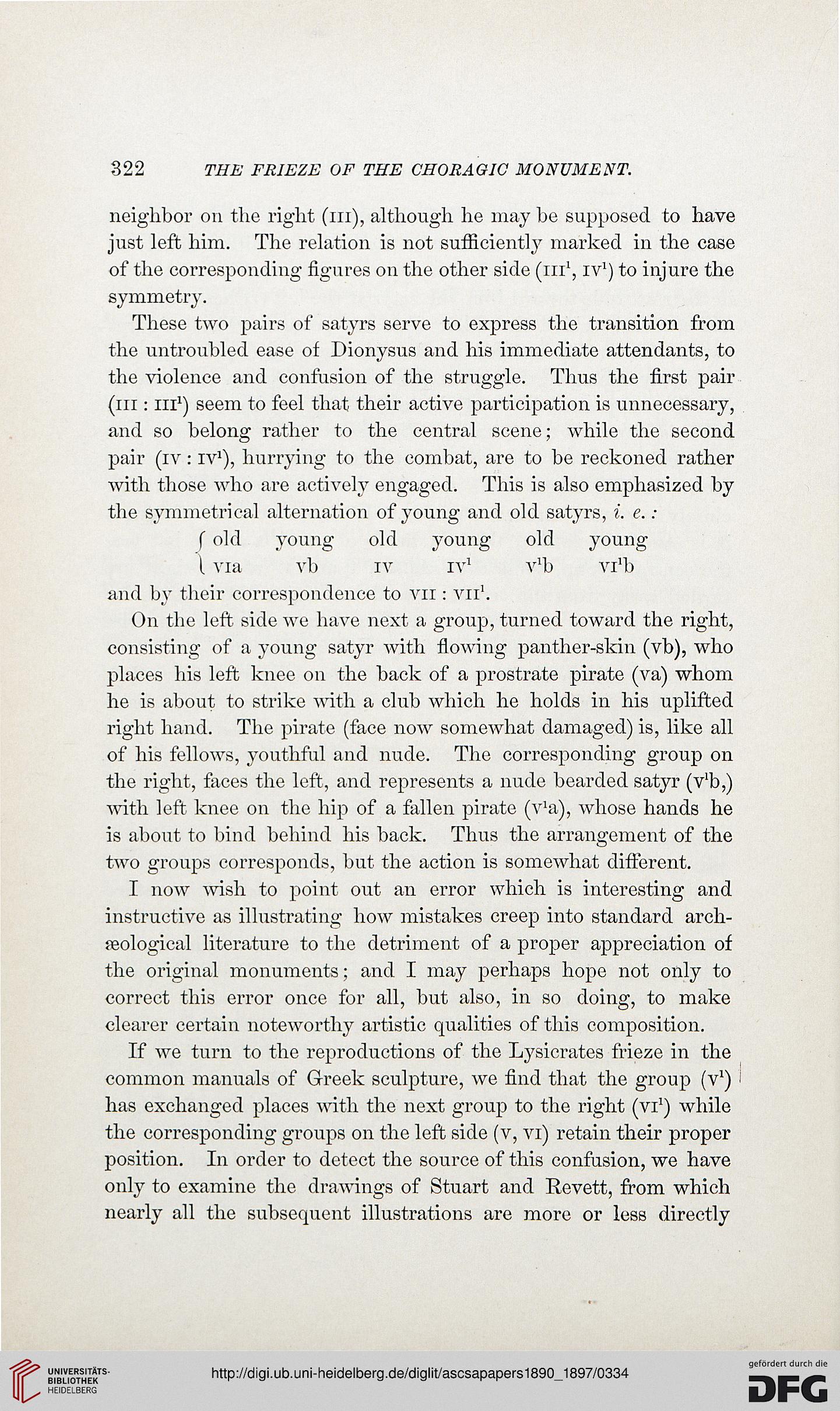322 THE FRIEZE OF THE CHORAGIC MONUMENT.
neighbor on the right (in), although he may he supposed to have
just left him. The relation is not sufficiently marked in the case
of the corresponding figures on the other side (in1, iv1) to injure the
symmetry.
These two pairs of satyrs serve to express the transition from
the untroubled ease of Dionysus and his immediate attendants, to
the violence and confusion of the struggle. Thus the first pair
(in : in1) seem to feel that their active participation is unnecessary,
and so belong rather to the central scene; while the second
pair (iv: iv1), hurrying to the combat, are to be reckoned rather
with those who are actively engaged. This is also emphasized by
the symmetrical alternation of young and old satyrs, i. e. :
( old young old young old young
1 via vb iv iv1 v'b vi'b
and by their correspondence to vn : vn1.
On the left side we have next a group, turned toward the right,
consisting of a young satyr with flowing panther-skin (vb), who
places his left knee on the back of a prostrate pirate (va) whom
he is about to strike with a club which he holds in his uplifted
right hand. The pirate (face now somewhat damaged) is, like all
of his fellows, youthful and nude. The corresponding group on
the right, faces the left, and represents a nude bearded satyr (v'b,)
with left knee on the hip of a fallen pirate (Va), whose hands he
is about to bind behind his back. Thus the arrangement of the
two groups corresponds, but the action is somewhat different.
I now wish to point out an error which is interesting and
instructive as illustrating how mistakes creep into standard arch-
aeological literature to the detriment of a proper appreciation of
the original monuments; and I may perhaps hope not only to
correct this error once for all, but also, in so doing, to make
clearer certain noteworthy artistic qualities of this composition.
If we turn to the reproductions of the Lysicrates frieze in the
common manuals of Greek sculpture, we find that the group (v1) '
has exchanged places with the next group to the right (vi1) while
the corresponding groups on the left side (v, vi) retain their proper
position. In order to detect the source of this confusion, we have
only to examine the drawings of Stuart and Revett, from which
nearly all the subsequent illustrations are more or less directly
neighbor on the right (in), although he may he supposed to have
just left him. The relation is not sufficiently marked in the case
of the corresponding figures on the other side (in1, iv1) to injure the
symmetry.
These two pairs of satyrs serve to express the transition from
the untroubled ease of Dionysus and his immediate attendants, to
the violence and confusion of the struggle. Thus the first pair
(in : in1) seem to feel that their active participation is unnecessary,
and so belong rather to the central scene; while the second
pair (iv: iv1), hurrying to the combat, are to be reckoned rather
with those who are actively engaged. This is also emphasized by
the symmetrical alternation of young and old satyrs, i. e. :
( old young old young old young
1 via vb iv iv1 v'b vi'b
and by their correspondence to vn : vn1.
On the left side we have next a group, turned toward the right,
consisting of a young satyr with flowing panther-skin (vb), who
places his left knee on the back of a prostrate pirate (va) whom
he is about to strike with a club which he holds in his uplifted
right hand. The pirate (face now somewhat damaged) is, like all
of his fellows, youthful and nude. The corresponding group on
the right, faces the left, and represents a nude bearded satyr (v'b,)
with left knee on the hip of a fallen pirate (Va), whose hands he
is about to bind behind his back. Thus the arrangement of the
two groups corresponds, but the action is somewhat different.
I now wish to point out an error which is interesting and
instructive as illustrating how mistakes creep into standard arch-
aeological literature to the detriment of a proper appreciation of
the original monuments; and I may perhaps hope not only to
correct this error once for all, but also, in so doing, to make
clearer certain noteworthy artistic qualities of this composition.
If we turn to the reproductions of the Lysicrates frieze in the
common manuals of Greek sculpture, we find that the group (v1) '
has exchanged places with the next group to the right (vi1) while
the corresponding groups on the left side (v, vi) retain their proper
position. In order to detect the source of this confusion, we have
only to examine the drawings of Stuart and Revett, from which
nearly all the subsequent illustrations are more or less directly




